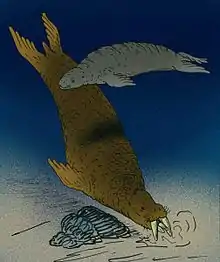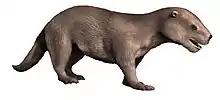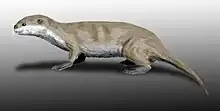Gomphotaria
Gomphotaria is a genus of very large shellfish-eating dusignathine walrus[1] found along the coast of what is now California, during the late Miocene.
| Gomphotaria Temporal range: Late Miocene, | |
|---|---|
 | |
| Restoration of Gomphotaria pugnax | |
| Scientific classification | |
| Domain: | Eukaryota |
| Kingdom: | Animalia |
| Phylum: | Chordata |
| Class: | Mammalia |
| Order: | Carnivora |
| Clade: | Pinnipedia |
| Family: | Odobenidae |
| Genus: | †Gomphotaria Barnes & Rashke, 1991 |
| Type species | |
| †Gomphotaria pugnax Barnes & Rashke, 1991[1] | |

Description
It was a huge-sized pinniped with skull length of around 47 cm (19 in), surpassed only by Pontolis, which had a skull of 60 cm (24 in) long.[2] Gomphotaria had comparatively small eyes, increased upper and lower canines and four tusks, with one pair in the lower and upper jaws. According to wear on the tusks, G. pugnax hammered shellfish open, rather than simply sucking them out of their shells as do modern walruses.[2] In terms of the postcranial skeleton, Gomphotaria and other dusignathine walruses were built more like sea lions than modern walrus. Gomphotaria is a prime example of the extreme diversity that walruses once exhibited.
References
- Barnes, L. G. and R. E. Raschke. 1991. Gomphotaria pugnax, a new genus and species of Late Miocene Dusignathine Otariid Pinniped (Mammalia: Carnivora) from California. Natural History Museum of Los Angeles County, Contributions in Science 426:1-16.
- Annalisa Berta (2017). The Rise of Marine Mammals: 50 Million Years of Evolution. Johns Hopkins University Press. p. 110. Retrieved 2022-08-21.


